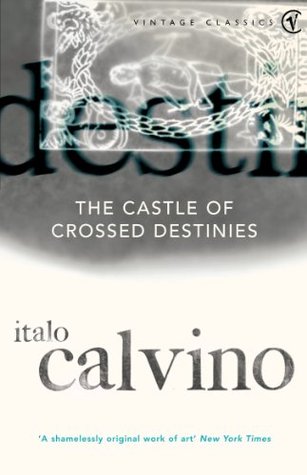It has been a couple of years since I first read Italo Calvino, picking up his wonderful if on a winter’s night a traveler on a whim and being captivated by its self-referential opening sentence. In the time since I’ve had a couple of half-hearted stabs at reading more (Invisible Cities and Mr. Palomar) but I’ve never really engaged with anything else. So, picking up The Castle Of Crossed Destinies (1977), I had my fingers crossed that it would be third time lucky for a resurrection in my Calvino interest.
The book is formed from two previously published collections, one named after this book, the other named The Tavern Of Crossed Destinies. In each Calvino delivers a series of short tales inspired by the laying out of tarot cards in horizontal and vertical patterns, interpreting them into the story, and with a print of each card, as they are evoked, running down the margins. It’s a wonderful idea, but despite its innovation I was never fully hooked.
The book is told within the frame of a disparate bunch staying a night in a castle and telling their stories through tarot cards, for they are mysteriously mute. The first series are based off tales, as Calvino thankfully notes in the afterword, from Ariosto’s Orlando Furioso, which I would never have guessed. As it’s a literary experiment, the first two were solidly structured, while those that followed were given up to fate. After all, what matter the cards that fall? Especially when, as Calvino expertly illustrates, each of the seventy-eight tarot cards offers up a multitude of interpretations:
The narrator, in fact, had begun arranging other cards in a new row, beside the first, on the left; he set down two cards, The Empress and the Eight of Cups. The sudden change of scene disconcerted us for a moment; but the solution quickly asserted itself, I believe, to us all, and it was that the knight had finally found what he had been seeking, a wealthy bride of high lineage, such as we saw depicted there, a crowned head, indeed, with her family shield and her insipid face – also slightly older than he, as the more malicious amongst us surely noted – in a dress all embroidered in linked rings as if to say, “Marry me, marry me.” An invitation promptly accepted, since the Cups card suggested a wedding banquet, with two rows of guests toasting the couple at the end of the festooned table.
So what this first set brings to the page is a gathering of Renaissance archetypes – the alchemist, the knight, etc. – and in the end all these stories overlap, leading to a larger number of permutations of the cards as yet untold. The second section follows suit, this time interpreting the cards as they land on the table as a palimpsest of classic tales: of Faust; of Oedipus; de Sade’s Justine. And from there, onwards, as Calvino tries to tell his story, and further still into an entertaining take on Shakespeare’s tragedies – Hamlet, King Lear, and Macbeth – all told from the same cards.
As an experiment, the concept works well and brings innovation to fiction, but as a work of fiction, despite the lovely translation by William Weaver, it’s a lack-lustre affair. The wow factor has gone by the end of the first collection and one can thank the fates that the author didn’t make good on his notion to pen a third installment. But it’s great to see how Calvino works his way from a single image and ascribes several meanings to it, as if he’s tossing a coin and calling tales every time.

I think this is on various lists of mine after an introduction to books with experimental form from Mr John Self himself!
I guess part of the reading experience of this kind of thing is to see whether the clever form stuff helps or hinders the strength of the literature itself. And it sounds a case of hinders here – but I think I’ll still give it a go. I like ‘If on a Winter’s…’ from what I remember.
Yes, if on a winter’s night a traveler was an absolute joy. I know what you mean about giving it a go, I have other Calvino books that I keep on coming to, get so far, and leave for the next time. It’s just a sad feeling that the most enjoyable Calvino may have been my first, so it’s (slight) disappointment from here on in.